|
|
Advertisement:
|
|
Asetek VapoChill Mk2 Premium Edition |
|
Join the community - in the OCAU Forums!
|
The Case in Detail
It's not every day one of these turns up on your doorstep..
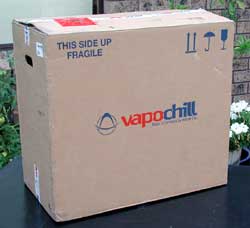
Without lingering on the box too much, it was nice to see that all the packing inside is folded cardboard. This is a more environmentally-friendly approach than the expanded polystyrene foam more commonly used.
Of course, when you purchase a VapoChill you are not just receiving a cooling system. The cooler is provided fully assembled into a custom ATX case. If the case were no good, it would sour the experience of owning the cooling system. Therefore, as is becoming almost traditional, let's take a quick stroll around the garden with the VapoChill case..
This is the "Titanium" version. That seems to only apply to the plastic fascia of the case, because the metal panels on the top and sides seem to me to be, well, black. I don't know about you, but I think the case looks great. It's perhaps a little porky-looking, with the fascia somewhat wide in the middle, but it definitely has a professional, server-like appearance.
There's a problem with black cases - CD-ROM or DVD drives and burners etc look very much out of place with their beige faces poking out of a snazzy black case. You can go the DIY route with a can of spraypaint (remove the faceplate first!) or some manufacturers offer black faceplates for drives as an option. I believe there are even third-party replacement faceplates now. If that's all too much hassle for you, the VapoChill is available in white which will match your boring beige drive covers nicely.
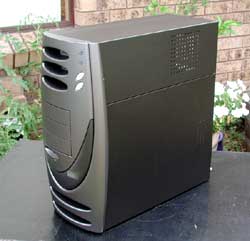 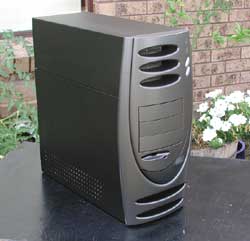
Once again, it's difficult to photograph shiny cases and get the colour in the photo to match what the eye sees in real life. The fascia is quite dark, almost a charcoal colour, and does match the case body quite well - better than in the pictures above. The picture on the previous page is more accurate. I've seen elsewhere, this case with the VapoChill logo between the top vents and the drive bays. Not sure why it's missing on ours. To be honest, I think it adds to the mysterious look of the case to not have it, so I don't mind.
From the back, we can see that the chassis itself is just sheet steel, not the more exotic aluminium seen in upmarket cases.
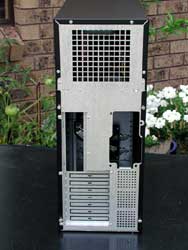
This might be dissapointing to some - certainly, it was one of the first negative things that both Manaz and I noted when we first saw the case - but realistically, VapoChill are trying to keep the price of this unit down. Throwing a case comparable to a Lian Li into the bundle would drive up the price considerably.
The two large holes in the back are of course for the ATX backplate and the power supply. Asetek did not provide a PSU with this case, although one is apparently available as an option. The unusual placement is because the top of the case is occupied by the VapoChill's cooling system. Asetek recommend using a PSU with a top-mounted fan to keep air flowing over the evaporator/cpu area.
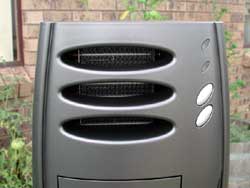
Looking closely at the top front vents we can see they're not just for show - there's a condenser or radiator behind them. The silver buttons at top right are Power (top) and Reset, while the LED's are ultra-bright blue, for Power (top) and HDD activity (bottom).
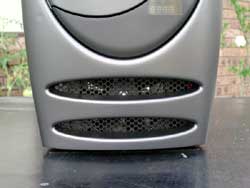
The front bottom vents are functional also - you can see the outline of a fairly hefty fan there, which as we'll see in a minute cools some drive bays.
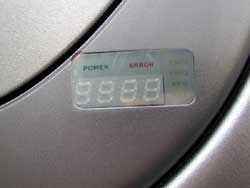
Another feature of the front is this small status panel. This is the indicator panel of the "ChillControl" unit, reporting temperature, fan RPM's and a user-programmed CPU speed. You use the reset button on the case to cycle through the information displayed, and you can even leave it automatically cycling every few seconds. This display also shows error messages, should anything unfortunate happen to the cooling system or during the startup procedure.
Taking the side-panels off is simple, with 2 thumbscrews on each side. Slide the panels back then lift them outwards - they come completely off the unit.
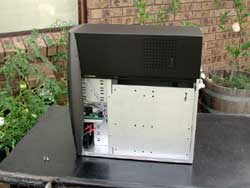 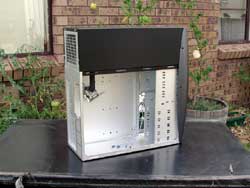
Looking inside the left side, we can see three 5.25" drive bays (all with front access) and five 3.25" bays, as well as a floppy drive bay. Note also the 120mm Papst fan, which is controlled by the ChillControl unit. This isn't always provided - it was included as an option on this review unit.
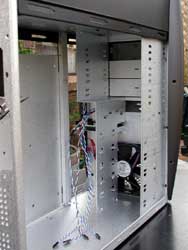
The fascia has a recessed floppy drive slot which, while fitting nicely with the rounded lines of the case, makes floppy drive usage annoying. It's a stretch for even my skinny fingers to insert a floppy disk and ejecting has you scrabbling for the protruding left-front corner of the disk. "I don't use floppy disks anyway", you may be saying - but as we'll see later, the VapoChill requires you to have a floppy drive for certain configuration and update tasks.
From the other side we can see the ChillControl unit itself:
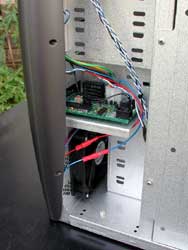
It's simply a PCB with a few wires going to it. It projects through the front of the metal chassis so that the display we saw earlier fits flush with the front of the case. The way this is located under the lowest 5.25" drive bay makes attaching cables from your power supply, as you must do, fairly difficult. To remove the ChillControl you have to remove the front fascia which is also quite fiddly - more on that later.
Removing the top is no great drama - there are 4 medium Torx screws, but they are crossed so a flat screwdriver can be used. The whole top panel lifts off in one long U-shaped peice, revealing the guts of the cooling system:
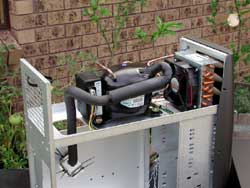 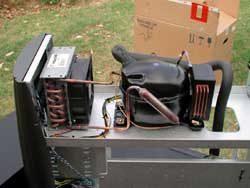
There we can see the large black compressor in the middle, the condenser (radiator) with hefty Sunon 120mm fan attached and the thick, insulated tubing leading down to the metal evaporator dangling in the motherboard area. Where's the capillary tube, you ask? The tubing from the condenser returns to the compressor, so I assume the capillary tubing is actually wrapped around the compressor body to save space. This would explain why the evaporator tubing seems to come direct from the compressor also.
All this cooling wizardry, plus the fact that this is a fairly large case made of steel, add up to it being a big heavy lump to lug around. It's also a fair bit deeper than most cases. With a motherboard, hard drive and power supply installed, t's noticeably heavier than my fully-populated AOpen HX08 full-tower - despite being 1.5 inches shorter.
You also get some other goodies in the box, with the case:
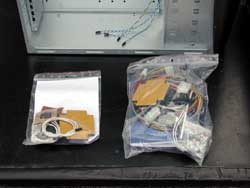
On the left, the smaller bag, is a spare Socket 478 installation kit provided by Asetek - normally you won't get that, so don't worry about it. On the right is the normal bag of extras you receive, and it's a hefty one. Inside is all this:
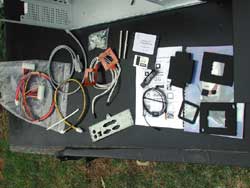
Excuse the skewed perspective in that photo, and we'll cover all this stuff in more detail during the Installation section, but from left to right we have:- power cable (goes from PSU to ChillControl and motherboard)
- grey ChillControl cable (from serial port to ChillControl, more on that later)
- white pipe-cleaner, for applying thermal paste
- yellow and black power cable (ChillControl to motherboard)
- 2 metallic square heating elements
- white coiled cables for connecting heating elements to ChillControl
- small bag of case screws, standoffs etc
- ATX backplate
- 2 metal bars that form part of the evaporator mounting system
- diskette with ChillControl software on it
- small black tube of Heat Conduction Compound
- thermal sensor - a thin black wire with a thermistor on one end and a jumper connector on the other
- picking sheet for socket 478 install kit
- 4 large peices of black insulation
- 2 small peices of black insulation - the small circular one is just a cutoff from one of the others and isn't used
- VapoChill Owners Manual (partly obscured by black case side)
Quite a lot of stuff. The manual deserves separate mention - it's an impressive ring-bounded job with a little over 100 pages, all in English. Presumably you can get manuals in other languages also. The manual is - for the most part - clear, with good English and many diagrams and photographs. It does have the feeling of having been translated from another language and occasionally the phrasing of technical items can be a little ambiguous - particularly during the installation of the evaporator. Speaking of which..
|
|
Advertisement:
All original content copyright James Rolfe.
All rights reserved. No reproduction allowed without written permission.
Interested in advertising on OCAU? Contact us for info.
|

|


